Iceland’s meteoric rise to one of the most popular tourist destinations in the world makes it essential to find new and unique ways to explore the island nation, and nothing allows for more options than road-tripping. Whether you’ve got three days, a week, or two weeks, exploring by car is an incredible way to see the country — from stunning waterfalls and black-sand beaches to glacier-capped volcanoes and seaside villages. Here’s how to get started.
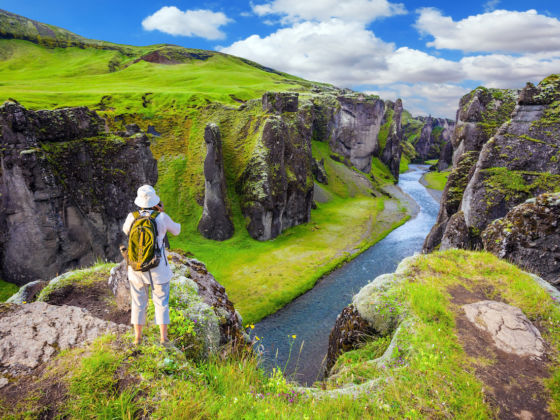
The Best Road Trips in Iceland -- From Three Days to Two Weeks
Driving in Iceland
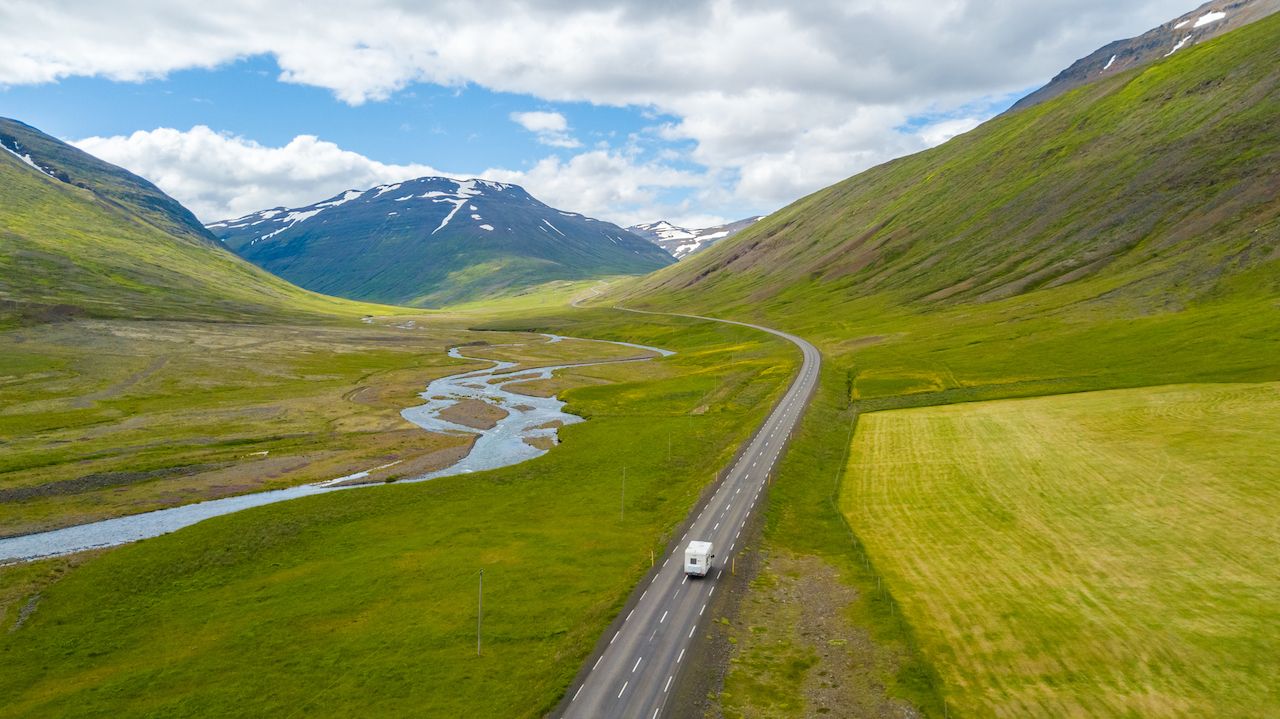
Photo: Lab Photo/Shutterstock
Many visitors stick to the capital city Reykjavik and its neighboring attractions because they believe Iceland is difficult to navigate by car. Actually, it’s extremely well-suited for road travel. Not only does Iceland take great care of its roads, but also not that many people live there, which makes uncrowded driving the norm.
For those on a budget, the upfront cost of a car — starting at US$300 a week, with more for an SUV — can seem like a lot. Yet given that free camping is ubiquitous in Iceland, it can actually be the most inexpensive way of seeing the notoriously pricey country. Plus, as a relatively small landmass, circumnavigation takes only a few days on the famed Ring Road, otherwise known as Iceland’s Route 1.
Driving in Iceland is similar to the US, with some notable exceptions. Most important to keep in mind is the weather, which “changes every five minutes” according to souvenir t-shirts sold in Reykjavik. The t-shirt is correct, and you may find yourself squinting through sleet or snow only to be frantically digging around for sunglasses a moment later. Even quick bouts of rain can change road conditions, so it’s important to stay vigilant, use common sense, and respect the local landscape by not driving around gates or marked signs. And though Iceland does maintain a highly skilled team of search and rescue volunteers in case of emergency, tourists driving where they shouldn’t put a strain on this resource.

Photo: Arsenie Krasnevsky/Shutterstock
One local driving tip that most tourists miss is how Icelanders pass each other. Most roads have one lane going each direction, meaning passing takes you into the oncoming lane. Icelanders signal to the cars behind them that it’s safe to pass by putting on their right-turn indicator. Of course sometimes they are actually just turning right, but because of the extended distances between towns and turn-offs, it’s pretty easy to tell what’s being signaled.
Gas station pumps are typically open 24 hours, and all of them sell pylsur, Iceland’s famous hot dogs (get them with fried onions). Another common roadside sight is hitchhikers, so don’t be alarmed if you spot someone thumbing a ride.
No matter how long you’re staying, or which way you’re going, flying in and out of the Reykjavík–Keflavík Airport is a given. This is the best place to rent a car, which is useful for stopping at the Blue Lagoon hot springs between the airport and Reykjavik; just be sure to reserve your spot well in advance.
Best three-day road trip: the Golden Circle and southern Iceland

Photo: Andrew Mayovskyy/Shutterstock
This is the most heavily trafficked region of Iceland, prized for its natural wonders and proximity to Reykjavik. Don’t expect to see anything that hasn’t been heavily photographed already, but do appreciate that these sites are popular for good reason.
Day one
The Golden Circle refers to a 300-kilometer, or 190-mile, route that goes through Iceland’s most popular natural destinations: Geysir Geothermal Area, Gullfoss Waterfall, and Þingvellir National Park, which is where this journey begins. Head to Route 36 from Route 1 and you’ll be there shortly.
Iceland’s only UNESCO World Heritage Site, Þingvellir — also spelled, and pronounced, Thingvellir — dates back to 930 CE. Meaning “fields of Parliament,” the area is where authorities from throughout Iceland convened once a year. Besides its historical value, this park is also where visitors can see the mid-Atlantic rift where two tectonic plates are pulling apart. It’s possible to SCUBA in the rift, which makes for a great photo op.
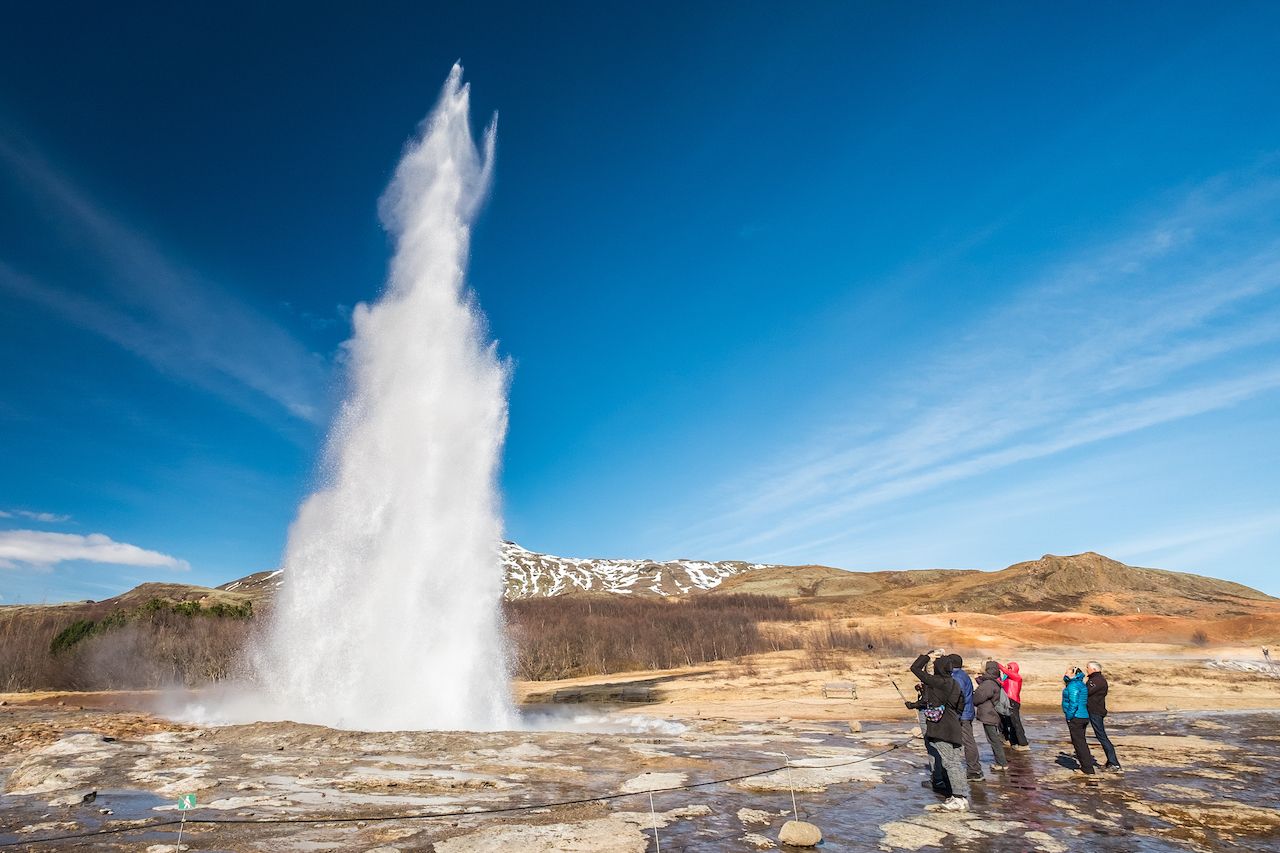
Photo: Puripat Lertpunyaroj/Shutterstock
The next stop is Geysir, the name of the largest geyser in the area and the origin of the word. While Geysir geyser is not very active today, a few steps away, the Strokkur geyser reliably shoots water 20 feet into the air every five to 10 minutes. Despite the popularity of this site, there’s not a lot besides the actual geysers, so be sure to keep an eye out for signs letting you know where you are.
In as much time as it takes for Strokkur to recharge, you can drive to Gullfoss, which translates to Golden Falls. This stunning two-tiered waterfall is beautiful from above, where the car park is, but it’s worth it to take the stairs down to feel the power of this iconic waterfall.
Day two

Photo: Guitar photographer/Shutterstock
Keeping along Route 1 — the Ring Road — you will arrive to Seljalandsfoss, a waterfall that can be fully encircled. Walk behind the majestic spray for a great photo op, which you may also find at Skógafoss, the next waterfall on the agenda. In between these two beauties, keep an eye out for Eyjafjallajökull on the left. This is the volcano that erupted in 2010 and prevented air travel over the Atlantic.
If you’ve had enough of driving to waterfalls, try hiking a bit of the Fimmvörðuháls trail, which takes 12 hours to tackle the entire thing. The whole thing features 26 waterfalls, Eyjafjallajökull, and Katla, a volcano that, if it erupts, will have far more devastating consequences than its neighbor.
Local tip: If you have time this day, and it’s summer, stop by the Ghost Museum in Stokkseyri for a real treat.
Day three
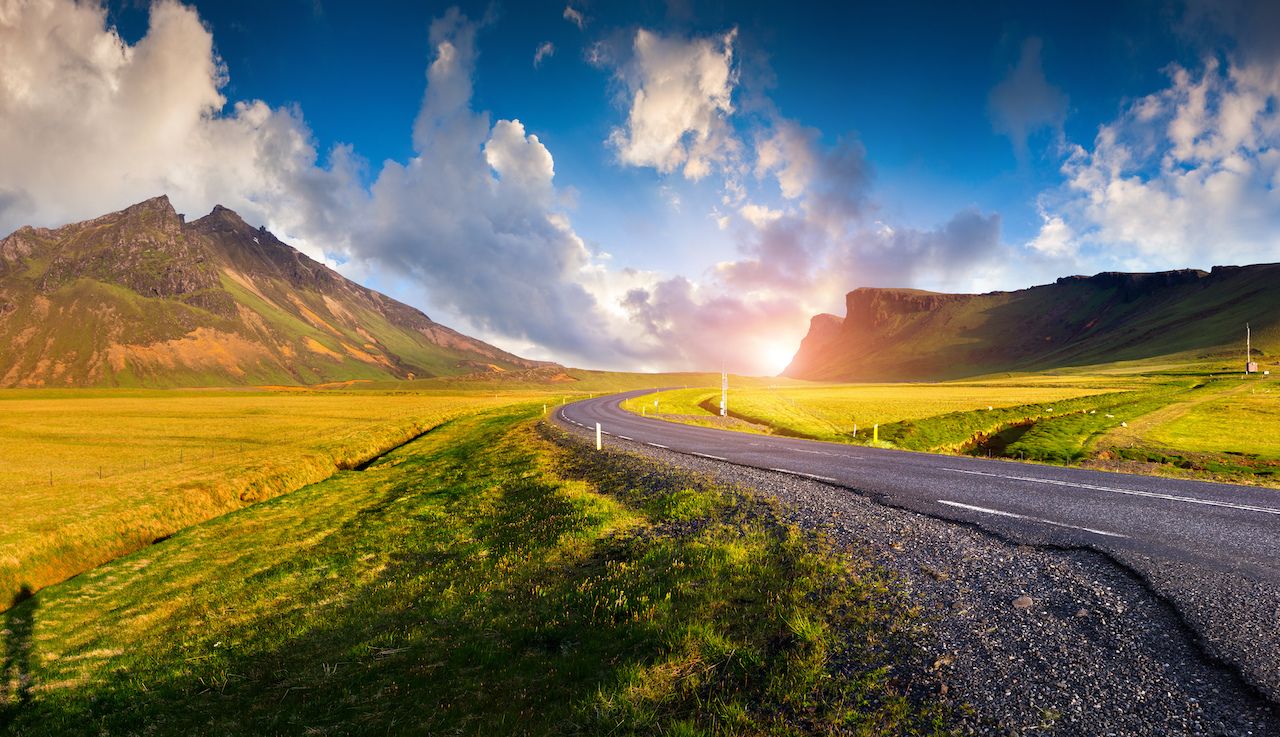
Photo: Andrew Mayovskyy/Shutterstock
Head to the Reynisfjara shore near the coastal village of Vik. This is where Iceland’s most famous black-sand beach resides. Being a volcanic island, there are numerous black-sand beaches, but this is the most trafficked. Game of Thrones fans will want to head to the nearby Höfðabrekkuheiði hiking area, where the Fist of the First Men was filmed. Stop by Skaftafell National Park for another beautiful waterfall, Svartifoss, with its trademark stone columns, or pop into an ice cave.
Finish exploring Southern Iceland by walking around or boating on Jokulsarlon glacial lagoon. Here you can witness the glacier calving and those icebergs heading out to see. Their color is unlike any other ice you’ve seen. Spring and summertime visitors should take note of the Arctic Terns nesting here and be careful not to step on their ground nests by sticking to the designated path. Not only is it cruel, but the parents will aggressively attack potential threats to their babies.
Best one-week road trip: the Ring Road
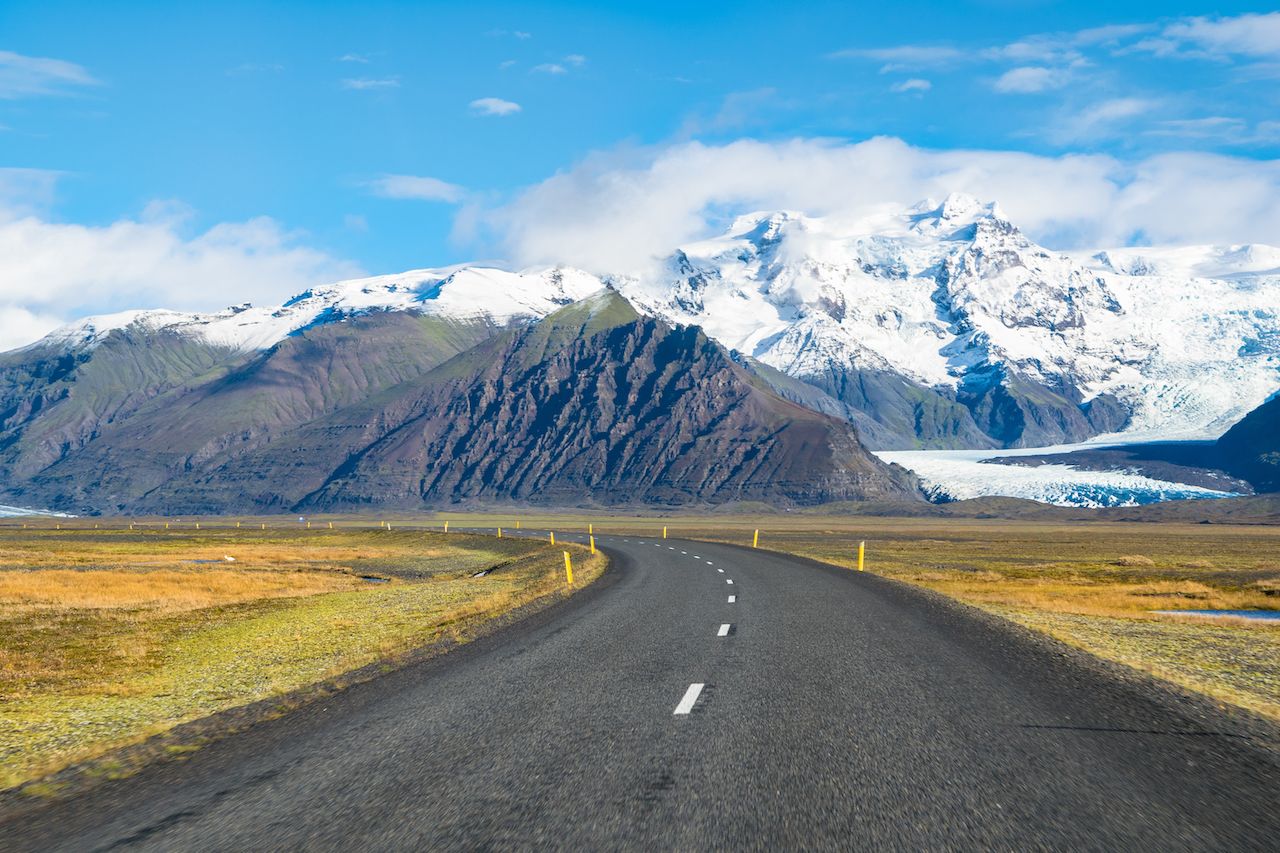
Photo: Nido Huebl/Shutterstock
A week in Iceland allows for many more options, including driving the entirety of the Ring Road. This will be ideal for travelers that want to see the best sights Iceland has to offer while still exploring off the beaten track. Road-trippers can choose to begin their journey by going north or south, but this guide will take the former route.
Day one
Head North along Route 1, during which you will drive through a long tunnel underneath Hvalfjörður and pass through a toll which costs 1000 ISK, or $8. When you reach Borgarnes, be sure to look out for Geirabakarí, which was turned into a Papa John’s for Ben Stiller’s movie The Secret Life of Walter Mitty. Once in Borgarnes, turn onto Route 54 towards the Snæfellsnes peninsula, the most famous sight of which is the monumental Snæfelljökull.
This double whammy of a volcano topped by a glacier is within a national park and has had quite an impact on the world. Readers of Jules Verne’s novel Journey To The Center Of The Earth may recognize this area as the setting of the book. Spend the day exploring the park before heading to nearby Stykkishólmur for a good night’s rest.
Day two
Today involves over five hours of driving up to Iceland’s capital of the North, Akureyri, though if it’s summer, there’s no need to fret about losing daylight. Even so, you’ll want to leave early enough to pause at anything that catches your eye during the ride and get as much time in Akureyri as possible.
Day three
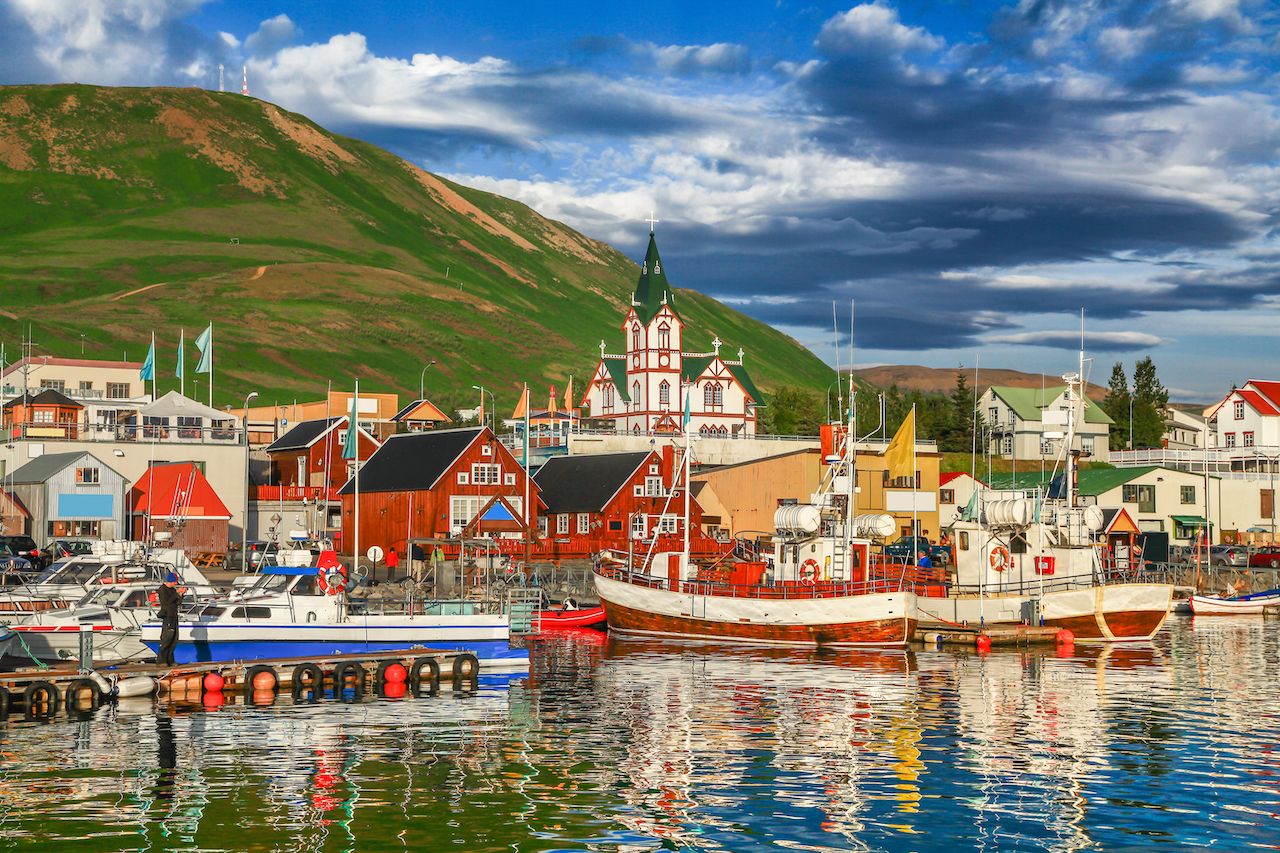
Photo: canadastock/Shutterstock
Take the morning to explore this underappreciated town. The downtown area is fairly walkable, with cute shops, art museums, and darling restaurants to sample. Local fare exclusive to this town is a MacGratsky burger, which is a regular cheeseburger with fries inside of it. This is sold at Nætursalan located downtown right next to the main bus stop. Akureyri is also home to the world’s northernmost Domino’s Pizza.
Continue along the Ring Road to Egilsstaðir, stopping at Mývatn, or “Mosquito Water,” along the way. It’s better than the name suggests. With mud pools, craters, and an overall moon-like feel, it’s easy to see why US astronauts did their training here before going to the actual moon. Check out the lake, which is inside a volcanic crater, and Dimmuborgir, a name which may be familiar to fans of heavy metal. Make sure to look for the Cave of the Yule Lads. There is a lot to see around here, so leave as much time as possible.
Finish the day at Egilsstaðir, which officially brings you into East Iceland, the least-visited region of the country.
Day four
From Egilsstaðir, continue on at a leisurely pace to Hofn. During this drive you’ll be encompassed by mountains on one side and the sea on the other, and it’s truly breathtaking. Upon approaching Hofn, the Vatnajökull glacier will appear on your right, and there are plenty of related activities to be had there. Winter is an especially spectacular time to visit as you can explore the ice caves. Alternatively, late June sees the mouth-watering Lobster Festival.
Days five-seven
Follow the three-day itinerary but in reverse to enjoy Jokulsarlon, the Golden Circle, and the rest of Southern Iceland’s best sights.
Best two-week road trip: the Ring Road and the Westfjords

Photo: Alexey Stiop/Shutterstock
Two weeks driving around Iceland is still not enough time to see everything, but it’s more than most take to explore this wonderful country. When traveling in winter, road conditions can slow traveling time, so it’s better to err on the side of two weeks when planning to visit that season.
The Ring Road component of this itinerary is taken from the one week option, with the addition of touring the Westfjords, another very underrated part of the country. Because it’s not along Route 1, and can take several hours to get to its largest town, many tourists skip it. Plus, it requires either a high level of driving skill and/or a car that can survive long gravel roads and circuitous mountain routes. (Author’s note: I did this in a 20-year-old VW Polo and it was fine.)
Day one
Head from Reykjavik to Snaefellsnes, following the footsteps of the One Week itinerary. Spend the night here before heading into the Westfjords.
Day two
Enjoy the sightseeing on the way to the tiny town of Reykholar. You’ll get here by taking Route 55 to 54 to 60. Búðardalur is a nice place to stop during the three-hour drive. There’s not a wealth of activities in this town, but the views are stunning, and it’s a great entry point to the Westfjords, which feel very distinct from the rest of the country. And if you’re lucky, you might spot the elusive white-tailed eagle, which makes the Westfjords its home.
Day three
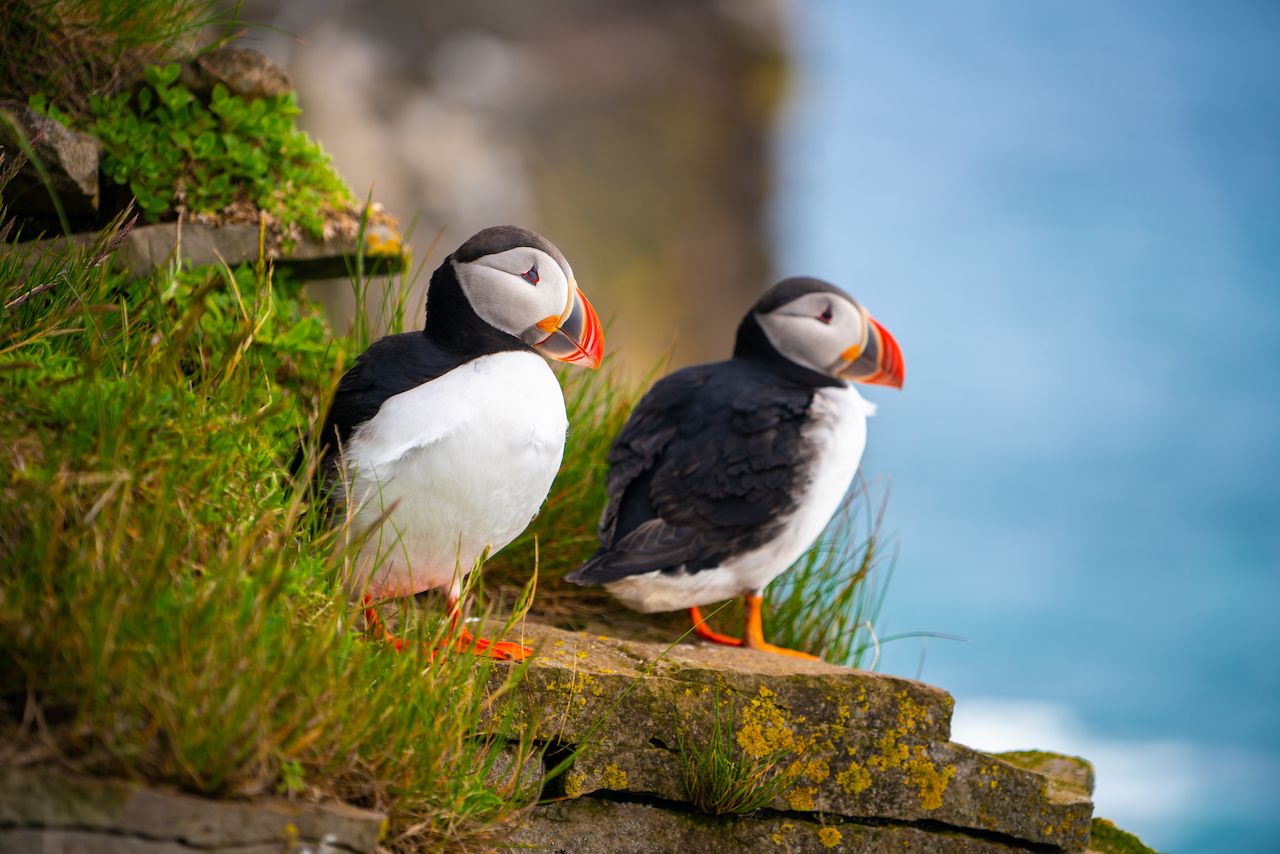
Photo: Blue Planet Studio/Shutterstock
Another three-hour drive brings you to a shining jewel of Iceland: the Latrabjarg bird cliffs. This cliffside colony of seabirds, particularly Atlantic puffins, is teeming with life so unaccustomed to humans that they don’t easily flee, making capturing photos here a cinch. However, be careful when seeking birds here as the edges of the cliff are not at all stable and shouldn’t be walked on. It’s best to army crawl close to the cliff edges (not at them, of course) to distribute weight more and lower the risk of tumbling. It’s a long fall.
Continue on to Patreksfjörður, which will take a little over an hour. Come back the way you came on Route 612 before popping over to 62. Here the public pool is a popular spot, and the town itself is lovely for walking around.
Day four

Photo: snapshopped/Shutterstock
This is going to be one of the most spectacular days of the Westfjords segment of the two week road trip. The goal is to get to Isafjörður, the largest city in the region with just over 2,500 residents, but there’s a lot to see along the way. On a map it looks like a huge distance, but without stopping the drive would only take three hours.
Take Route 63 until the first stop, which is the village of Bíldudalur, home of the Icelandic Sea Monster Museum. On the outskirts of town, be sure to keep an eye out for road signs warning drivers of such monsters. The museum is like many Icelandic museums in that it’s expertly crafted and informative.
Next up is Dynjandi, the grand waterfall of the Westfjords. To reach it, head North on Route 60 from 63. Stop here and hike up to the base of the falls — it’s higher up than it seems. The view over the fjord is stunning, especially when the sun is shining on the water. If it’s not, “just wait five minutes for the weather to change” as Icelanders like to say.
Continue on to the final destination of the day, Isafjörður, the capital of the Westfjords. You’ll spend the night and the next day here exploring nearby attractions.
Day five
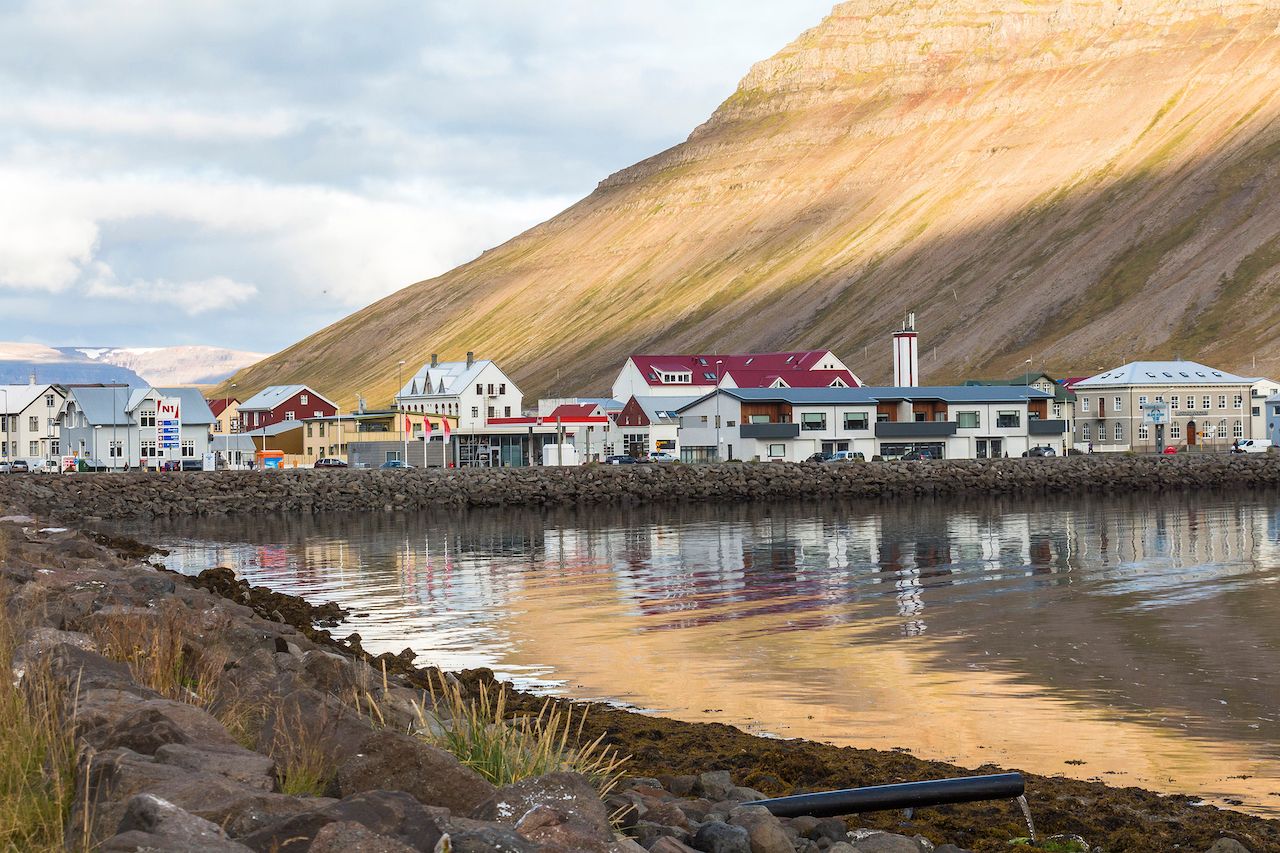
Photo: Robin Runck/Shutterstock
There’s plenty to do around Isafjörður. Only 15 minutes outside of town is the Arctic Fox Centre, where they sometimes have rescued foxes being prepped for release. Check out guides to the city for more information on what to do while there. If it’s especially clear out, try to spot Greenland to the West.
Day six
Before heading out of the Westfjords, take a day trip to Hornstrandir, a nature reserve with no development on it. The feeling of remoteness is remarkable, and arctic foxes are generally pretty easy to spot.
Day seven
Today is a long day of driving — it takes seven hours to drive to Akureyri via Route 61to 68, which brings you back to Route 1, the Ring Road. Hólmavík makes for a nice stop, with the Museum of Icelandic Witchcraft and Sorcery being the main attraction.
Day eight
Take a day in Akureyri to enjoy Iceland’s second-most populated city. Refer to the One Week itinerary for more detail on what to do, and consult guides to select activities.
Day nine
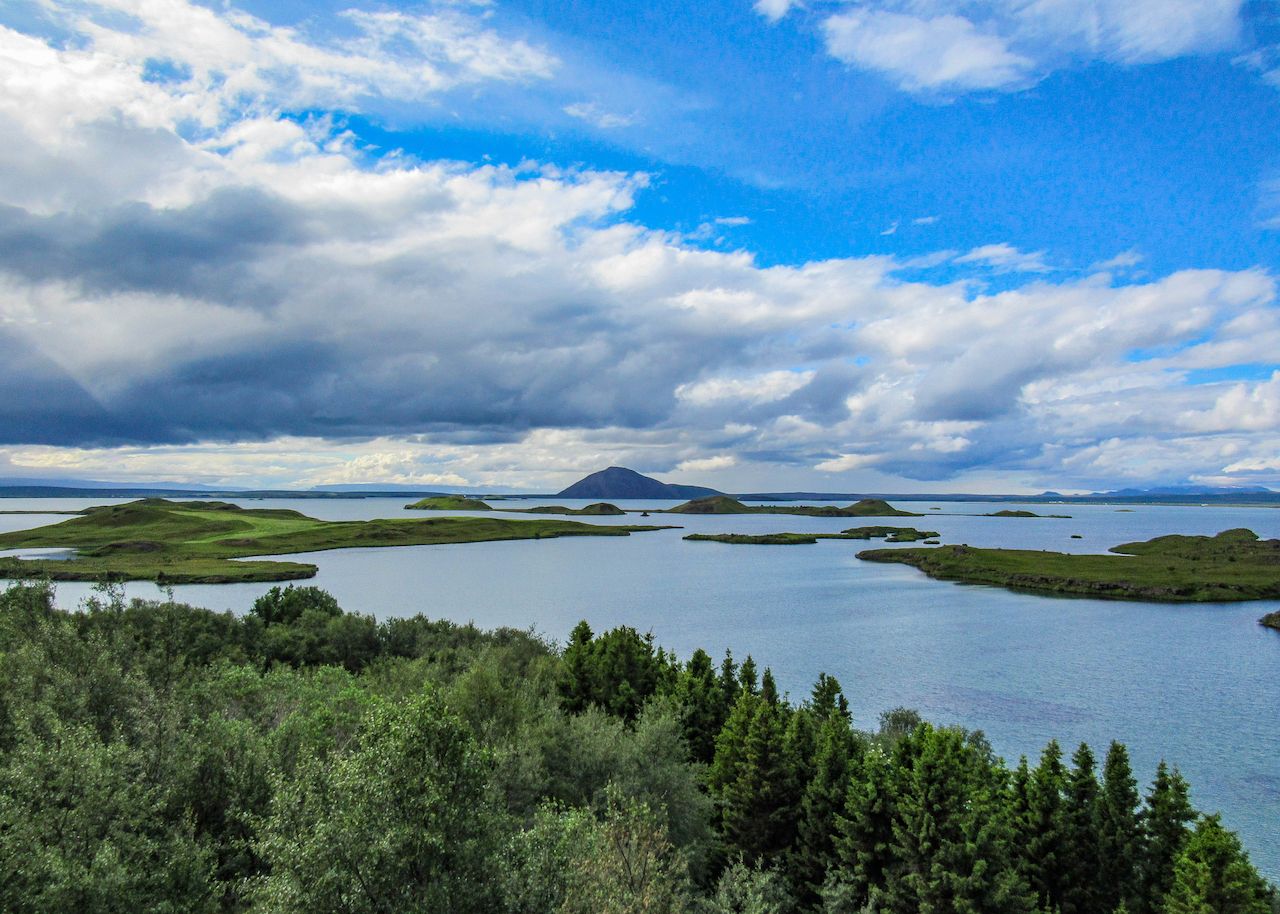
Photo: nomadkate/Shutterstock
Continue along the Ring Road to Myvatn, which has numerous attractions to explore. It only takes an hour to get here from Akureyri, so make use of the extra time to see everything this unique area has going on.
Day 10
Two hours on the Ring Road will bring you to Egilsstaðir and the Eastfjords, a truly underexplored region of Iceland. There are numerous waterfalls to check out in the area, as well as cultural experiences unique to the East.
Day 11
From Egilsstaðir, continue on at a leisurely pace to Hofn. During this drive you’ll be encompassed by mountains on one side and the sea on the other, and it’s truly breathtaking. Upon approaching Hofn, the Vatnajökull glacier will appear on your right, and there are plenty of related activities to be had there — as noted above.
Days 12-14
On your final three days of this two week road trip through everything Iceland has to offer, check back with the itinerary for the Golden Circle and Southern Iceland.